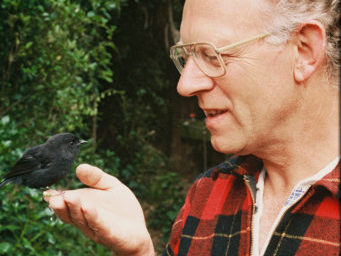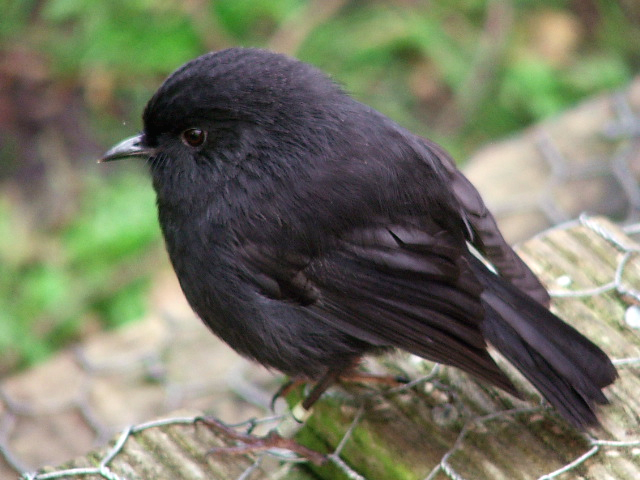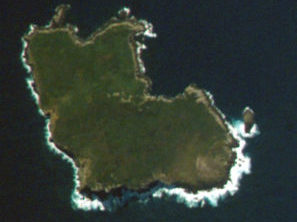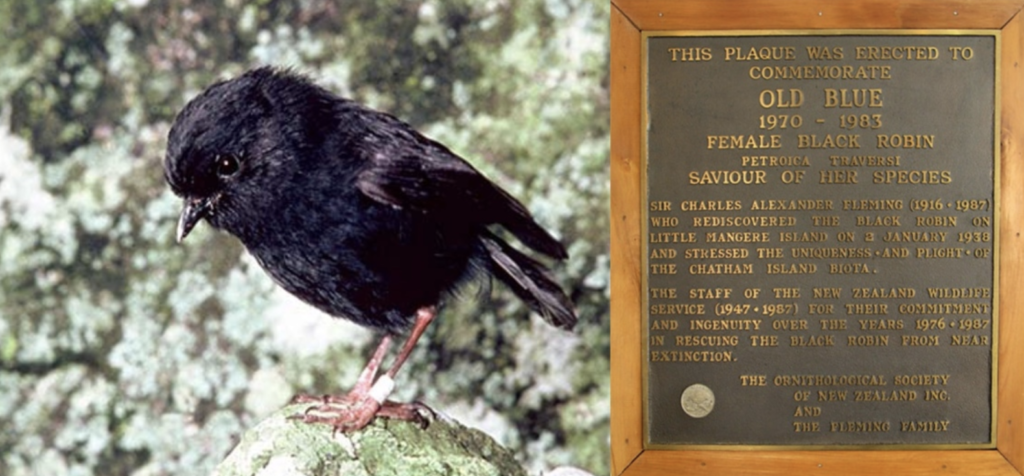Don Merton (1939-2011) was a passionate pioneer in the conservation of endangered birds. His work was recognised world-wide and for 30 years he worked with the kakapo recovery programme.

But there was another, even rarer bird that he and his team brought back from the very brink of extinction – the Chatham Island black robin. This is the story of Don Merton and a tiny black bird known as ‘Old Blue’.
Don Merton made his first trip to the Chatham Islands in 1968 and saw black robins for the first time. The Chatham Island black robin is closely related to mainland New Zealand bush robins, but smaller and entirely black. They had been ‘rediscovered’ in 1938 in an expedition led by Sir Charles Fleming and, when Don and other wildlife officers visited in 1968, they estimated there were 30 birds left – all living on tiny, rugged, but predator-free Little Mangere Island.

Little Mangere Island is just off the western end of Mangere Island, about 4 km west of Pitt Island and is roughly 15 hectares in size. It has a flattish interior, surrounded by steep cliffs and has a tiny summit forest. Buffeted by ocean winds and wild weather, it was an inhospitable place for the world’s last remaining black robin population.
Don Merton and others in the Wildlife Service (later to become the Department of Conservation) were already considering where and how they could safely transfer some breeding pairs to another, larger, predator-free island to help spread the risk in case of a catastrophic predator invasion, disease or weather event. But first they needed to learn more about black robins, to find out how best to safely transfer them.
So the Wildlife Service studied and ‘practised’ with our much more common mainland robins, discovered they were very tolerant of disturbances at the nest and practised transferring them short distances as they modified the design of their robin travel boxes.
Meanwhile, back on Little Mangere, black robin numbers were slowly but steadily declining. Don led an expedition back to the Chathams in 1972 and rowed his team across the short stretch of rough water between Mangere Island and Little Mangere in an old, battered 3-metre-long aluminium dinghy with a small hole in the bottom. A small fountain of sea water spouted out the hole and no-one on the dinghy had life-jackets, but luck was with them and they managed without serious mishap. The team caught and banded as many black robins as they could find – and estimated that there were now only 26 birds left.
The need to establish a new population was urgent – but where? Mangere Island was the closest but it was also small and the black robins would have to compete with tomtits for food. South East Island was much larger – but also had tits – and would a few black robins even be able to find one another in its much larger forest? And then there was the transfer itself. Like mainland robins, black robins are friendly and inquisitive so not too hard to find and catch. But the team then needed to get them safely down Little Mangere’s precipitous cliffs. There was much they still needed to work out before a transfer could be attempted.
In January 1973, Don returned to the Chathams once more. Included in his team was an experienced climber who helped attach a specially made 5-metre ladder to the cliffs, along with fixed ropes to aid climbing. Access was now much easier, but reportedly still pretty scary.

The black robins were counted again, but the news was grim. Since they had last counted 26 birds a year earlier, there had been a severe winter and dry summer. Four of their nine banded birds had disappeared and the team could only assume the same proportion of unbanded birds had probably been lost as well. What’s more, there were very few juvenile birds that summer. The total world population of black robins was somewhere between 17 and 19 birds. It was now the rarest bird in the world for which numbers were known.
For the next 3 years, Don Merton was fully involved in working to save kakapo. Others in the Wildlife Service continued to study and count black robins. In 1974 there were 12 adult birds, a year later just 11. Each year the number of chicks successfully raised, barely managed to replace the adults that were lost. The tiny forest on Little Mangere was also rapidly deteriorating due to salt and wind damage and blankets of Muehlenbeckia vines that enveloped and swamped the canopy.

Don Merton and others argued urgently for intervention. Don wanted to try moving some birds to adjacent Mangere Island. He was overruled. In the summer of 1975-1976 there were just 9 known black robins. Returning in winter 1976, the wildlife service team found 8.
In August 1976, while on Maud Island checking kakapo, Don Merton got an urgent call from his Wellington bosses. He was needed for a black robin transfer trip – happening in just a few weeks’ time.
Finally it was all on for the black robins – and not a moment too soon. When they got to Little Mangere, the catching team could only find 7 black robins alive. Only two of them were females. One of them – named for her identifying band, was a female later to become famous as ‘Old Blue’.
Initially, the team had been authorised to transfer just one breeding pair to Mangere Island, but with only two breeding pairs left in the world, the situation was desperate. They decided to risk moving the second breeding pair as well.
First they transferred an unpaired male. All went well. Next they caught the first of the breeding pairs. ‘Old Blue’ and her mate were placed in a carry box and carefully carried down the cliffs. It was a momentous journey – the first step in a world-first conservation intervention that would ultimately lead to ‘Old Blue’ saving her species from extinction.
Wild weather delayed the catching and transfer of the second breeding pair for a couple more days, but soon they too joined ‘Old Blue’, her mate and the single male, making 5 black robins on Mangere and two lone males still on Little Mangere. In the first breeding season on their new island home, the single male disappeared, but a female chick fledged. In March 1977, the two lone males on Little Mangere were also caught and carried across the water to their new home.
For the next few years, numbers stayed precariously low. In the summer of 1977 two chicks joined the population – but two adults had disappeared. Still 7 black robins. A large slip that winter destroyed a big area of bush, making life harder for the robins. In the summer of 1978-79 there were still only 7 birds in total – and the population was back to just two females. One of them was ‘Old Blue’. By the end of that season there were just 5 black robins left alive – including a single breeding pair. The Chatham Island black robin was now, indisputably, the rarest bird in the world.

In 1980 the decision was finally made to manage the black robin population intensively. Moving the population to Mangere Island hadn’t been enough to save them and they were on the very brink of extinction.
Don Merton now became significantly involved in the black robin programme, which aimed to produce as many chicks as possible. The team returned to Mangere Island to find there were now just 5 adult black robins, one fledgling and a nest with one chick and an egg.
The fledging belonged to ‘Old Blue’ and her new mate ‘Yellow’. Now 9 years old, Old Blue had already survived nearly twice as long as the average robin. Old Blue’s mate Old Yellow had hatched on Mangere Island in the summer of 1977-1978 and was her mate from the 1978-1979 breeding season onwards. He would go on to father all 6 of her surviving chicks.
The nest belonged to an unbanded female (later to be banded as ‘Green’) and the male ‘White’ (Old Blue’s previous mate). Tragically, after a wet, stormy night, the team found Green’s chick missing and her egg cold.
When Don removed the cold egg, Green began working on a new nest. This evidence that black robins will re-nest if disturbed was a key piece of information as Don and the team formulated their plans for the next breeding season.
In the next few years a key part of saving the black robins was Don Merton’s innovative technique of fostering eggs and chicks to other species. This allowed the black robins, helped out by duped foster-parents, to nest two or even three times in one season.
This daring technique was first tried out in the breeding season of 1981/1982 when the team returned to find just 5 black robins surviving: Old Blue and Old Yellow, Green and her mate White and the previous year’s chick (from Blue and Yellow).
It was a nerve-wracking time of egg and chick juggling. Removing eggs and destroying the nests of the world’s rarest bird – without actually knowing whether the robins would re-nest or whether the warbler foster parents would succeed in rearing robin chicks was a huge risk! If it hadn’t worked, the team would have hastened the extinction of the species!
Thankfully it did work – although not without near disaster. Blue’s chick, fostered by warblers was found dead at 11 days old. It was well-developed and well-fed, but the nest was fouled by droppings.
The team found that warblers could successfully incubate robin eggs and rear chicks for the first few days, but they couldn’t raise them to fledgling age. The chicks needed to be returned to black robin nests – although the complicated juggling logistics meant that Blue and Yellow ended up successfully raising Green’s chick that first season, while Green and White successfully raised Blue’s two chicks. By summer’s end, the black robin population was up to 8!
With the failure of warblers as long-term foster parents, tomtits on South East (Rangatira) Island were the foster parents of choice in the summer of 1981-82, with warblers on standby as a back-up to incubate eggs or raise robin chicks for the first few days only. It meant another step in the process as the eggs had to be transferred by boat to South East Island – meaning a longer time out of the nest for the eggs. Another innovation tried successfully that year was to remove Green’s new nest from an insecure site and put it into a nest box at the same location. Green carried on nest-building, unperturbed.

That year three of Blue’s chicks were successfully reared by tomtits on South East, then taken back to Mangere Island. Blue also successfully reared her last two eggs to fledgling. But it was not a good year for Green. Of her first two eggs, one didn’t hatch and the other chick died at 2 days old. She laid again, but both these chicks died soon after hatching. Red mite infesting the nest were one possible cause.
Green nested a third time. One egg was infertile, but she hatched and reared one chick. Unfortunately it died later that summer as a fledgling. So by summer’s end in 1982, the black robin population had increased to 12 birds – but all 5 chicks that year had Blue and Yellow as parents.
After she grew too old for breeding, Old Blue was controversially ‘retired’ to South East Island in 1983 in the hope that her longtime (but younger) mate Old Yellow might pair with Green (which would have added more genetic variation to the population) – but Yellow and Green had different ideas and Old Yellow chose one of his daughters instead.
Black robins live 4-5 years on average. Old Blue survived to reach 13 or 14 years of age, finally disappearing some time in 1983 or early 1984. While her time on South East Island was short, Don Merton was reportedly pleased she got to live out her retirement there. Apparently there had been a ‘high-level proposal to take and preserve her as a stuffed speciman’.
Old Blue was seen on 30 November 1983, in pleasant, sunny bush and reportedly looking good. She was observed again on 13 December 1983, but never seen again.
In her geriatric years Old Blue and Old Yellow produced 6 chicks. Every black robin alive today is descended from those 6 birds. By 2013, 30 years after Old Blue’s death, there were 250 of Old Blue’s descendants living on Mangere and South East (Rangatira) Islands in the Chathams – showing that as long as one breeding pair remain, it’s possible to bring a species back from the very brink of extinction. Because robin numbers dropped so low, however, the genetic diversity once present in the black robin species is forever lost.
Read more about Don Merton’s work, including the black robins’ story in Don Merton – the man who saved the black robin by Alison Balance (Reed Publishers).

